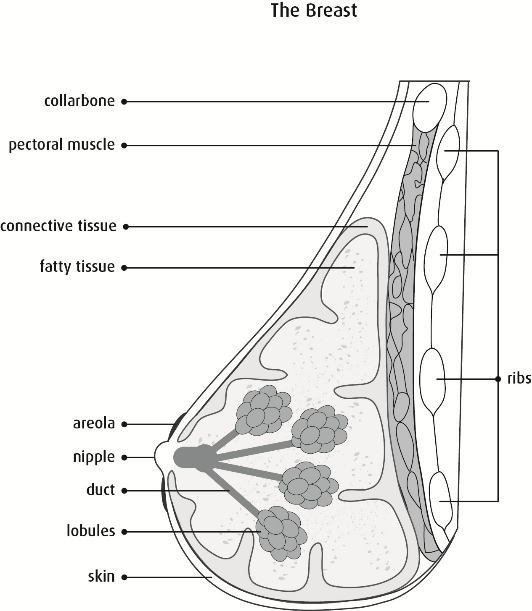It can be helpful to understand the parts of the breast (anatomy), how cancer is measured (staging and grading), and the role hormones play in the body and breast cancer.
Your Breast
The
female breast has lobes, ducts, fat tissue, and supporting ligaments. Your breast tissue starts from under your arm, continues up to the collar bone, and into the centre of the chest. Inside the breast there are lobes and ducts.

Copyright © 2017 Canadian Cancer Society. Graphic used with permission.
Lobes are made up of small, tube-like structures called lobules. Lobules contain milk glands that make milk for breastfeeding. Ducts carry milk from the lobules to the nipple. Fatty tissue surrounds the breast. The breast has lymph vessels and lymph nodes to protect the body against infection and diseases.
The
male breast is a lot like the female breast. Male breast cancer is rare. The treatment for men with breast cancer is much like the treatment for women with breast cancer. Care after surgery is the same for both men and women.
There are different kinds of breast cancer. Your healthcare team will discuss your type of breast cancer with you.
Breast Cancer Staging
The stage of your breast cancer is a way for your healthcare team to find out how much cancer there is and where it is in your body. Sometimes the cancer is not just in one area. Your doctor will be able to tell you the stage of your breast cancer after all of your tests, biopsies, and surgeries are complete. Most doctors use the
TNM way of staging cancer—see the
TNM Staging Chart.
T is the tumour size,
N is if the cancer is found in your lymph nodes, and
M is if the cancer is found in other areas of the body (metastasized).
Your treatment plan options will depend on the stage of your cancer.
TNM Staging Chart for Cancer
|
| T (tumour) |
N (lymph nodes) |
M (metastasis) |
|
TX: Unable to measure tumour.
Tis: Tumour hasn't grown through the wall of the duct into nearby tissue (in situ).
T1 to
T4: Tumour of increasing size (numbers 1 to 4 describe how large the tumour is).
|
NX: Unable to evaluate lymph nodes.
N0: No cancer found in lymph nodes.
N1 to
N3: Cancer has spread into lymph nodes. (numbers 1 to 3 are based on how many nodes are involved).
|
M0: Cancer hasn't spread to other parts of the body.
M1: Cancer has spread to other parts of the body.
|
Breast Cancer Grading
Grade is a “score” that tells how different the cancer cells look and grow compared to normal, healthy breast cells. The pathologist (a doctor who specializes in cells and tissue), will decide the grade. They’ll rate the cancer on a scale of 1 to 3:
-
Grade 1 or low grade (sometimes called well differentiated): Grade 1 cancer cells look a little different from normal cells and grow in slow, well-organized patterns. Not many of the cells divide to make new cancer cells.
-
Grade 2 or intermediate/moderate grade (moderately differentiated): Grade 2 cancer cells don’t look like normal cells and grow and divide a little faster than normal.
-
Grade 3 or high grade (poorly differentiated): Grade 3 cancer cells look very different from normal cells and grow and divide quickly in disorganized and irregular patterns.
Hormone Receptors
Your cancer cells may be tested to see if they have
estrogen or
progesterone receptors. When estrogen and progesterone hormones attach to these receptors, they may make your cancer grow. Even if you’ve been through menopause, your body still makes estrogen and progesterone. Cancers are called hormone receptor-positive or hormone receptor-negative based on if the cells have these receptors. About 80% of cancers are hormone-receptor positive.
Your hormone receptor results are part of your cancer treatment plan. Discuss your results with your surgeon and cancer specialist.
HER2 status
In about 20% of breast cancers, the cells make too much of a protein called
HER2. These are called HER2-positive breast cancers. HER2-positive breast cancers tend to grow and spread faster than other breast cancers, but there are treatments that work very well for them.
Your HER2 results are part of your cancer treatment plan. Discuss your results with your surgeon and cancer specialist.
